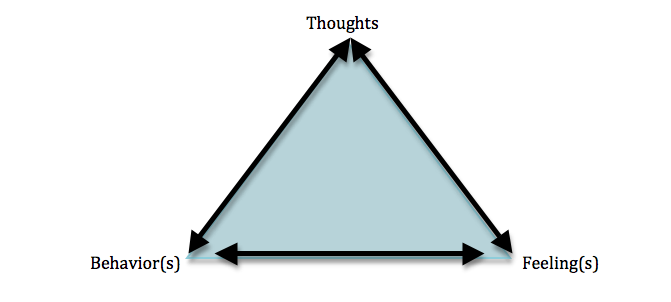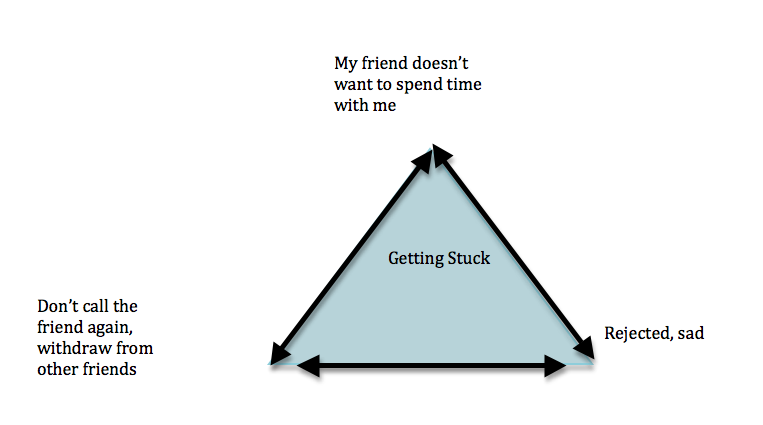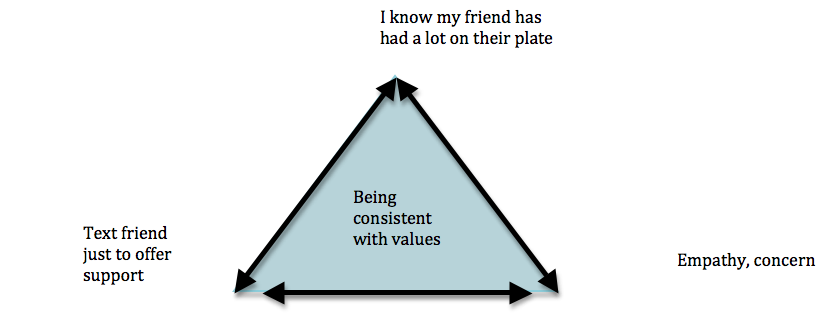Challenging Negative Thinking
Negative thinking. Thinking Errors. Cognitive Distortions. Stinkin’ Thinkin’. Maybe you’ve heard these terms before? Regardless of the name you give them, these are thoughts that typically would be called negative and tend to make us feel bad. Negative thoughts in and of themselves tend to not have too much of an effect on us. However, when these thoughts lead to negative emotions, we usually want to escape or change these emotions.
From the cognitive model, thoughts, feelings/emotions, and behaviors are interconnected and create a loop that can cause a person to feel stuck. For example, a situation can occur – maybe a friend didn’t call or text you back when you invited them to go to dinner. This situation can trigger numerous thoughts, one of which may be that your friend didn’t want to spend time with you. A thought like that can evoke many emotions such as sadness, anger, loneliness, or rejection. When a person experiences emotions, they tend to have associated behaviors or ways to handle that emotion. This can create a loop where a person’s thoughts, emotions, and behaviors continued to perpetuate a mood.
What you may notice is that each arrow is double sided. This is to demonstrate that there is no one direction this loop can take. While thoughts can lead to specific emotions, the opposite is just as true and even certain behaviors a person takes can lead to new thoughts, good or not so good.
With regard to the example above, the thoughts, emotions, and behaviors that may occur for someone who didn’t hear back from a friend could look like this:
In this example, not hearing back from a friend can lead to feelings of rejection and sadness. When a person feels rejected or sad, this may cause them to no longer want to take the risk of calling their friend for fear of more rejection. This can even generalize further where the thought of trying to call any friend feels threatening and the person may withdraw from most or all social interaction over time.
Continued social withdrawal can lead to getting stuck. By this I mean if a person withdraws, continued thoughts of feeling alone and rejected may occur. This would likely lead to deeper feelings of sadness, which then again increases withdrawal behaviors. It’s easy to see how this loop can cause a person to feel badly and in some cases contribute to more serious concerns, like depression.
But let’s instead say that when you didn’t hear back from your friend, you had the thought that they must be really busy. Maybe they’ve had a lot going on in their life this week making it difficult to connect with others. Your thought-feeling- behavior cycle might look like this:
The prompting event was exactly the same, but the interpretation of the event (thought) was different, resulting in a very different set of emotions and behaviors. So how do we challenge and change thoughts? If you have a propensity to worry or ruminate on situations resulting in more negative thoughts, learning to evaluate if your thoughts are accurate or not can be incredibly helpful in changing your mood and feeling better. The link to this worksheet below may aid you beginning the process.
At first, this thought log may look pretty simple and in theory it is. The idea is that you would track situations/events/prompting experiences that are tied to negative thoughts, difficult emotions and so on. You then work through the chart left to right to practice examining your thoughts for accuracy. Although potentially simple in theory, it takes practice, repetition, and consistency to get to a point where you naturally have more balanced thinking. It can be hard to examine our thoughts and feelings in the more objective way and it's not unusual to feel overwhelmed when first trying the skill out. Practice can help! If you are seeing a mental health professional, you may bring it to them to help or practice with a close friend who can aid you in looking at the situation a little differently.
If you’re hoping to try this skill, I recommend printing out a few copies and taking them along with you to use in real time when you experience a negative thought. At first this skill may feel unnatural. However, with time you’ll likely find that your mind begins to challenge thoughts without the use of going through the worksheet and that your thoughts tend to be more balanced from the outset.
Give it a try and see if you can break the loop with your negative thoughts!


